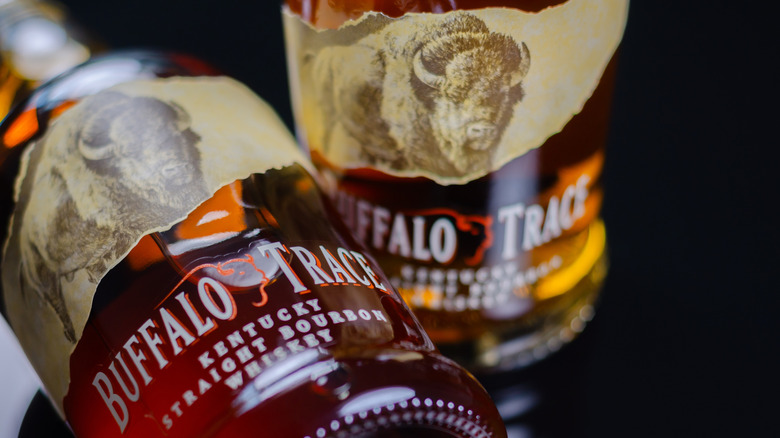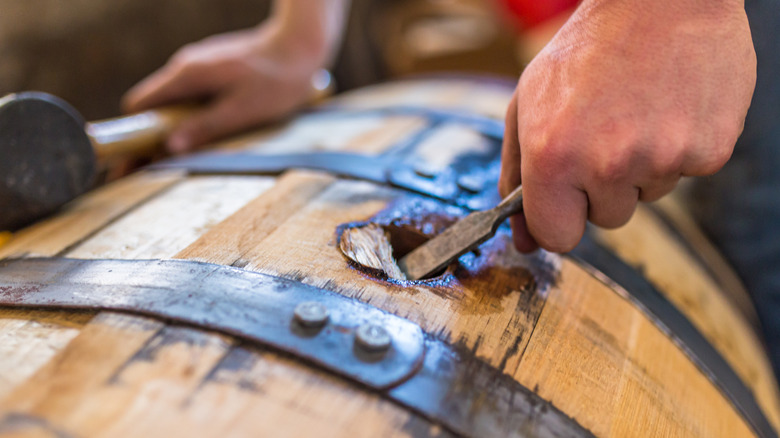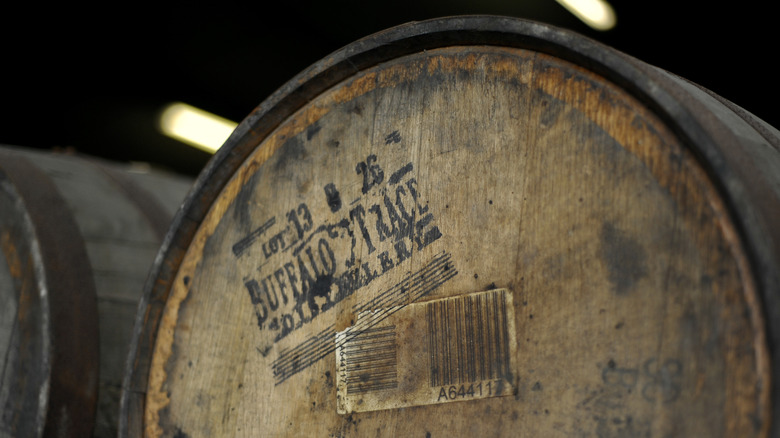How Long Is Buffalo Trace Bourbon Aged?
What might seem like a fairly straight-forward question, the matter of how long Buffalo Trace bourbon is aged isn't straight-forward at all. Buffalo Trace Distillery, America's oldest distillery, is based in Frankfort, Kentucky, in a state that's long been the center of bourbon production for many reasons. Buffalo Trace not only produces bourbon under its own label, but also has the rights to other brands like E.H. Taylor, Jr., Van Winkle, and Eagle Rare. All are distilled at the Buffalo Trace Distillery under the guidance of Master Distiller Harlen Wheatley. However, each brand, including Buffalo Trace's own label, comes with different recipes and different aging times. This is why it's tricky to say definitively how long the company ages its bourbon whiskey (and, yes, there are differences between bourbons and other whiskeys).
That said, it is possible to get an idea about how long some of its bourbons are aged. For example, Eagle Rare is aged for at least 10 years, as is the Mongolian Oak brand. It's also worth mentioning that some versions of Eagle Rare sit in barrels for up to 25 years. And Buffalo Trace's Pappy Van Winkle 23 Year was aged, unsurprisingly, for 23 years.
How a distiller determines aging times
More goes into determining how long a Buffalo Trace bourbon is aged than just its recipe. Bourbon production is a highly regulated industry, and some of those regulations determine the exact makeup of its mash bill and how long all U.S. bourbon distilleries age their spirits. Laws pertaining to the production of bourbon have been on the books since at least the 1800s and have been morphing since that time. For example, the Pure Food and Drug Act of 1906 determined that "straight bourbon" must be aged for at least two years and up to four.
However, it's more than laws that keep bourbon in the cask. Taste is a determinant, too. Case in point? A two-year-old bourbon doesn't have such a sophisticated profile, so most bourbons sit in their barrels for at least four years to help the flavor of the liquor to develop more fully. Flavor is at the mercy of other factors, like a distiller's skill, the conditions inside the barrel, where it is located in the distillery, and the type of oak used to make the barrel.
The law also stipulates that bourbon must be aged in new charred oak barrels. The char acts as quasi-seal, as well as a filter for the bourbon. As the booze ages, it begins to take on the barrel's different flavors, which can include caramel, vanilla, shortbread, fruit, oak, and more. The longer the distillate stays in the barrel, the deeper the color and the flavor become. Because of tradition and the law, that bourbon barrel can only be used once to make bourbon, though other kinds of alcohol may be aged inside these used barrels.
Other elements Buffalo Trace must consider
Buffalo Trace history goes back several centuries. However, it hasn't always seen the billion-dollar production it does today. Before the mid- to late-1990s, the bourbon industry was struggling. Bottling lines at Buffalo Trace ran around twice a week and distilling took place for only a few months of the year. Sales were low, but production gradually turned upward when the distiller was acquired by the Sazerac Company in 1992, then took on the Charter and Weller brands of bourbon during the late 1990s. Buffalo Trace took on its current name and released its namesake brand in 1999.
All of this is to say that to produce a 10-, 15-, or 20-year-old bourbon, the company would have had to start production on those bourbons 10, 15, or 20 years ago when the its production ability wasn't up to par and the demand for bourbon wasn't the same. According to Harlen Wheatley, "We [Buffalo Trace] plan based on the demand for today." However, an uptick in demand doesn't negate a bourbon's need to sit in the barrel for an extended amount of time. Remember that, to be considered bourbon, the law dictates it. Their brand recipes dictate it. And most importantly, the aging process dictates it. Buffalo Trace bourbons are always going to be aged for years before they see the inside of a bottle.


